|
|
GameStop is Between a Rock and a Hard Place Video game retail sales in the U.S. have been in the doldrums ever since they hit a high point back in 2009. However, this was then easily explained. Everybody was waiting for the new consoles to come out in 2012 and 2013 and did hence hold back on buying games for the older console versions. Things would turn sharply north once the eighth generation machines were becoming available. The first of them, the WII U, hit the market place in November 2012. While the machine initially flew off the shelves, software sales did not budge. In fact, they continued to drop. Again, this did not worry people because, after all, the real heavyweights – the Xbox One and the PS4 – were going to launch in November 2013 and this would trigger the long-awaited turnaround for video games. The two releases came and both consoles have since then broken all records. But software continued to slide consistently and the last reported month, June 2014, was no exception. This is how things developed: 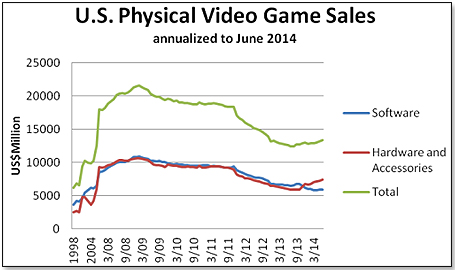 The gurus who had been predicting a video game resurgence had, however, been right except it just did not happen in quite the way they had imagined. What occurred was that the same people who had bought the new consoles from the retailers also decided to go elsewhere for their video games – they went directly to the publishers from whom they could download the games. This trend had in fact started much earlier. The publishers – Activision and Electronic Arts in particular – had over the past seven or eight years made a consistent effort to shift consumer purchases away from retail to downloads, motivated by three factors. One was that they could pocket the retailer margin of about 20%. The second was that downloaded games are much more difficult to pirate – and pirating worldwide accounts for about 20% of all games sold at retail. The third was that downloaded games cannot, unlike boxed games, be resold as used games – and the publishers are completely excluded from the highly lucrative used game market dominated by GameStop. This is what in reality happened to video game sales in the U.S. according to the Klosters Retailer Panel and the national buyers: 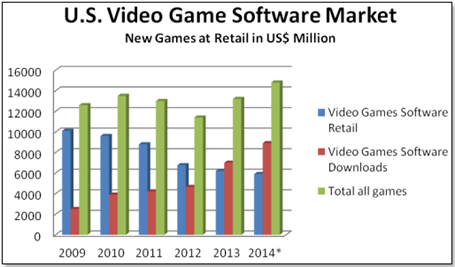 In other words, the total U.S. video game market started to decline in 2010 and began to turn around again in 2012 – when the WII U launched. The rapid rise in downloads more than compensated for the decline in retail sales. This trend is expected to continue, not only in the United States but worldwide, and downloads are anticipated to represent more than three-quarters of all video game sales by 2020. This should not have come as a surprise to anybody who followed the two leading publishers – Electronic Arts and Activision. This is how their shipments went – boxed games sold at retail versus downloads: 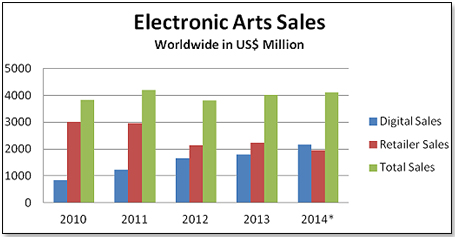 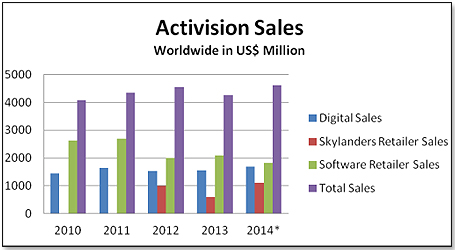 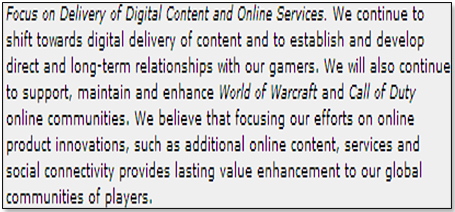 As the charts above demonstrate, the strategy employed by the publishers is definitely working for new software sales. But it is also working in regard to used games as demonstrated by GameStop’s published sales numbers: 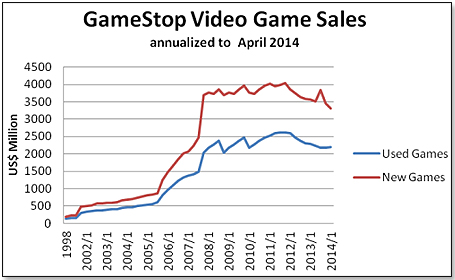 This chart tells us that GameStop’s used game sales march in tandem with their new software sales. This, of course, makes eminent sense. You buy a new game from GameStop, you play it, and then you sell it back to them in order to buy another new game and so forth; except, of course, that this cycle is broken once you buy a game no longer from GameStop but rather digitally from the publisher. Their used games business is now facing a new threat – Wal-Mart, who has begun to delve (again) into the used games business. They are buying used games and now have also begun to reselling them. One difference is that their purchase prices and selling prices are much better than those offered by GameStop. Early July, the two retailers had the following offers for Call of Duty Black Ops II for the Xbox 360:
Normally I would have said that there was no contest. Wal-Mart offers the better deal by far but then, pricing is not everything. In the case of GameStop, you get immediate service from a very nice and knowledgeable kid who is only too happy to tell you all you need to know about the game and about anything else that could interest you. In the case of Wal-Mart, you wait at the Entertainment counter for about 15 minutes before anybody shows up and then knows virtually nothing about video games. So, if you need help, you go to GameStop. If you know what you are doing, want to save some real money, and have lots of time, you go to Wal-Mart. The used game business is of particular importance for GameStop as this is not only a very large part of their sales but an inordinately high component of their profitability – nearly half for the quarter ending April 30, 2014. The example of CoD Black Ops II pricing above tells the story why this business is so lucrative. Obviously, GameStop management recognizes the problem they are facing and are trying very hard to change their model. One of their efforts, logically, is to piggyback onto the download locomotive. So far, they have not been overly successful. For the quarter ending April 2014, their digital business represented a mere $56 million worldwide (2.8% of total quarterly sales) and was flat compared to the same quarter last year. The company’s challenge is to expand their digital business faster than what they are losing to downloads from their retail business. At this point, their new software sales – representing 36% of their current annualized sales - are most affected. However, there is absolutely no reason why consoles, which now represent 20% of their annual sales, should remain impervious to the online trend. The second effort is to diversify away from their current product base. In order to do so, GameStop bought recently two small retailers – Simply Mac and Spring Mobile - and entered into a franchisee arrangement with a third, AT&T-owned Cricket Wireless. Simply Mac was bought in November last year, has 23 stores, and sells all Apple products. Spring Mobile was bought at the same time, has 164 stores, and is an AT+T retailer for mobility products and services. As for Cricket Wireless, GameStop operates now 31 stores (out of a total of more than 200 Cricket Wireless stores) as a franchisee. Cricket Wireless sells smart phones, basic cell phones, phone accessories, and AT+T plans. GameStop has coined the term “Technology Brand” for these stores and expects to expand their total from the current 218 to 450 by end of this year. At the same time, the company expects to close more than a hundred of their current stores (after having closed 118 stores already during the last twelve months). There are a couple of problems with this strategy. The first is that the model that has made GameStop so successful in the video game space will not necessarily work in the mobile consumer technology market place. GameStop succeeded in video games because they were better at it than anybody else. That does not apply to the smart phone market place now dominated by BestBuy, Verizon and other heavyweights who have been in this space so much longer and presumably have a major advantage in terms of expertise and established consumer following. The second is that current sales of these Technology Brand stores are peanuts – about 5% of GameStop’s total and partly offset by sales losses due to the closing of regular stores. Thirdly, profitability is low at about half of what you would expect from an established GameStop store due, presumably, to the absence of the extremely lucrative used game business. Finally, there is no reason to assume that smart phones are resistant to the trend to online buying. My friends at Amazon tell me that sales of these gizmos are skyrocketing and this would suggest that the transition from brick-and-mortar stores to the digital world is well under way also in this case. In fact, consumer electronics are the category most bought online as demonstrated by the chart below: 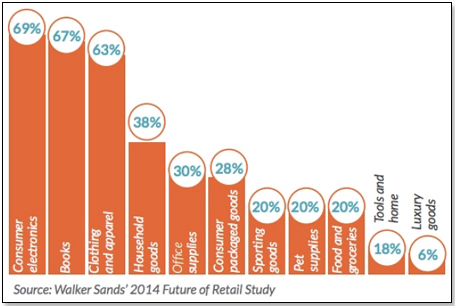 GameStop’s basic problem appears to be muddled strategic thinking. If your consumer moves to the online market place then building more brick-and-mortar stores is unlikely to be the answer. GameStop’s management has essentially two choices – either get ahead of the digital curve or die the slow death of a thousand cuts.  Writer's Bio: Lutz Muller is a Swiss who has lived on five continents. In the United States, he was the CEO for four manufacturing companies, including two in the toy industry. Since 2002, he has provided competitive intelligence on the toy and video game market to manufacturers and financial institutions coast-to-coast. He gets his information from his retailer panel, from big-box buyers and his many friends in the industry. If anything happens, he is usually the first to know. Read more on his website at www.klosterstrading.com. Read more articles by this author Writer's Bio: Lutz Muller is a Swiss who has lived on five continents. In the United States, he was the CEO for four manufacturing companies, including two in the toy industry. Since 2002, he has provided competitive intelligence on the toy and video game market to manufacturers and financial institutions coast-to-coast. He gets his information from his retailer panel, from big-box buyers and his many friends in the industry. If anything happens, he is usually the first to know. Read more on his website at www.klosterstrading.com. Read more articles by this author |
| |||||||||||||||||||||||||||||||||||||||||
Disclaimer Privacy Policy Career Opportunities
Use of this site constitutes acceptance of our Terms of Use.
© Copyright 2025 PlayZak®, a division of ToyDirectory.com®, Inc.



